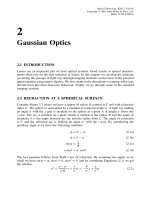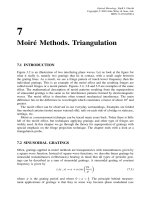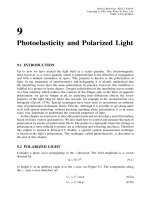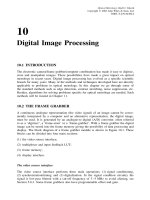Đo lường quang học P4
Bạn đang xem bản rút gọn của tài liệu. Xem và tải ngay bản đầy đủ của tài liệu tại đây (318.47 KB, 31 trang )
4
Diffraction
4.1 INTRODUCTION
When light passes an edge, it will deviate from rectilinear propagation. This phenomenon
(which is a natural consequence of the wave nature of light) is known as diffraction and
plays an important role in optics. The term diffraction has been conveniently defined by
Sommerfeld as ‘any deviation from rectilinear paths which cannot be interpreted as reflec-
tion or refraction’. A rigorous theory of diffraction is quite complicated. Here we develop
expressions for the diffracted field based on Huygens’ principle of secondary spherical
wavelets. It is a very fortunate coincidence that the aperture and the diffracted far field
are connected by a Fourier transform relationship. Because of that, optics and electrical
engineering have for a long time shared a common source of mathematical theory.
As a consequence of diffraction, a point source cannot be imaged as a point. An
imaging system without aberrations is therefore said to be diffraction limited.
4.2 DIFFRACTION FROM A SINGLE SLIT
Figure 4.1 shows a plane wave which is partly blocked by a screen S
1
before falling
onto a screen S
2
. According to geometrical optics, a sharp edge is formed by the shadow
at point A. By closer inspection, however, one finds that this is not strictly correct. The
light distribution is not sharply bounded, but forms a pattern in a small region around A.
This must be due to a bending of the light around the edge of S
1
. This bending is called
diffraction and the light pattern seen on S
2
as a result of interference between the bent
light waves is called a diffraction pattern.
Another example of this phenomenon can be observed by sending light through a small
hole. If this hole is made small enough, the light will not propagate as a narrow beam
but as a spherical wave from the centre of the hole (see Figure 4.2). This is evidence
of Huygens’ principle which says that every point on a wavefront can be regarded as
a source of secondary spherical wavelets. By adding these wavelets and calculating the
intensity distribution over a given plane, one finds the diffraction pattern in that plane.
This simple principle has proved to be very fruitful and constitutes the foundation of the
classical diffraction theory.
With this simple assumption, we shall try to calculate the diffraction pattern from a
long, narrow slit (see Figure 4.3). The slit width a in the x
0
-direction is much smaller than
Optical Metrology. Kjell J. G
˚
asvik
Copyright
2002 John Wiley & Sons, Ltd.
ISBN: 0-470-84300-4
68
DIFFRACTION
S
1
S
2
A
Figure 4.1
Figure 4.2
a
x
0
x
z
r
Figure 4.3
the slit length in the y
0
-direction. We therefore consider the problem as one-dimensional.
From the left, a plane wave with unit amplitude is falling normally onto the slit. According
to Huygens’ principle, the contribution u(x) to the field at a point x from an arbitrary
point x
0
inside the slit is equal to the field of a spherical wave with its centre at x
0
:
u(x) =
e
ikr
r
(4.1)
DIFFRACTION FROM A SINGLE SLIT
69
To calculate the total field at the point x, we have to sum the Huygens’ wavelets from
all points inside the slit. This sum turns into the integral
u(x) =
a/2
−a/2
e
ikr
r
dx
0
(4.2)
Applying the Fresnel approximation (Equation (1.12)), this yields
u(x) =
e
ikz
z
a/2
−a/2
e
i
k
2z
(x−x
0
)
2
dx
0
=
e
ikz
z
e
i
k
2z
x
2
a/2
−a/2
e
i
k
2z
x
2
0
e
−i
k
z
xx
0
dx
0
(4.3)
By moving the observation plane away from the slit such that
z
kx
2
0max
2
the quadratic phase factor inside the integral can be set to unity. We then get the simple
expression
u(x) =
K
z
a/2
−a/2
e
−i
k
z
xx
0
dx
0
=
K
−ikx
[e
−i
k
z
xx
0
]
a/2
−a/2
=
Ka
z
sin
πa
zλ
x
πax
zλ
(4.4)
where we have collected the phase factors outside the integral into a constant K.The
intensity becomes proportional to
I(x)=|u(x)|
2
= a
2
sin
2
πa
zλ
x
πax
zλ
2
(4.5)
In deriving Equation (4.4), we have made some approximations. These are called
the Fraunhofer approximation in optics. To justify this approximation, the observation
plane must be moved far away from the diffracting object. A simple way of fulfilling
this condition is to observe the diffraction pattern in the focal plane of a lens (see
Section 4.3.2).
In Figure 4.4, the Fraunhofer diffraction pattern from a single slit according to
Equation (4.5) is shown. The distribution constitutes a pattern of light and dark fringes.
From Equation (4.5) we find the distance between adjacent minima to be
x =
λz
a
(4.6)
We see that x is inversely proportional to the slit width. It is easily shown that the
diffraction pattern from an opaque strip will be the same as from a slit of the same width.
70
DIFFRACTION
0.1
0.2
0.3
0.4
0.5
1.0
l
(
X
)
l
(0)
l
z
a
−3
l
z
a
−2
l
z
a
−
l
z
a
l
z
a
2
l
z
a
3
x
0.008
0.017
0.047
Figure 4.4 Diffraction pattern from a single slit of width a
It should be mentioned that according to a more rigorous diffraction theory, the field
at a point P behind a diffracting screen is given by
u(P ) =
1
iλ
u(P
0
)
e
ikr
r
cos ds(4.7)
where denotes the open aperture of the screen, ds is the differential area, u(P
0
) is the
field incident on the screen and is the angle between the incident and the diffracted
rays at point P
0
. Equation (4.7) is known as the Rayleigh-Sommerfeld diffraction for-
mula. When putting u(P
0
) = 1 (normally incident plane wave of unit amplitude) and
= 0, this formula becomes equal to Equation (4.2) except for the factor 1/iλ which
becomes unimportant for our purposes, since we will be mostly concerned with relative
field amplitudes.
4.3 DIFFRACTION FROM A GRATING
4.3.1 The Grating Equation. Amplitude Transmittance
Figure 4.5 shows a plane wave normally incident on a grating with a grating period equal
to d. The grating lines are so narrow that we can regard the light from each opening as
cylindrical waves. In Figure 4.5(b) we have drawn three of these openings, A, B and C,
DIFFRACTION FROM A GRATING
71
d
A
B
C
−q
1
z
q
1
q
2
Figure 4.5 Diffraction from a square wave grating
each with five concentric circles separated by λ representing the cylindrical waves. The
tangent to circle number 5 for all openings will represent a plane wave propagating in
the z-direction.
The tangent to circle 5 from opening A, circle 4 from B and circle number 3 from C
will represent a plane wave propagating in a direction making an angle θ
1
to the z-axis.
From the figure we see that
sin θ
1
= λ/d
The tangent to circle 5 from opening A, circle 3 from B and circle 1 from C will represent
a plane wave propagating in a direction making an angle θ
2
to the z-axis given by
sin θ
2
= 2λ/d
In the same manner we can proceed up to the plane wave number n making an angle θ
n
to the z-axis given by
sin θ
n
= nλ/d (4.8)
Equation (4.8) is called the grating equation. Also in the same manner we can draw the
tangent to circle 5 from opening C, circle 4 from B and circle 3 from A and so on.
Therefore n in Equation (4.8) will be an integer between −∞ and +∞.
The grating in Figure 4.5 can be represented by the function t(x) in Figure 4.6. This
is a square-wave function discontinuously varying between 0 and 1. If the wave incident
on the grating is represented by u
i
, the wave just behind the grating is given by
u
u
= t(x)u
i
(4.9)
Therefore, behind the grating plane u
u
= u
i
where t(x)= 1, i.e. the light is transmitted
and u
u
= 0 wherever t(x)= 0, i.e. the light is blocked.
72
DIFFRACTION
d
x
t
(
x
)
1
Figure 4.6 Amplitude transmittance t of a square wave grating
The function t(x) is called the complex amplitude transmittance of the grating. We have
seen that such a grating will diffract plane waves in directions given by Equation (4.8).
If we turned the propagation direction 180
◦
around for all these waves, it should not be
difficult to imagine that they would interfere, forming an interference pattern with a light
distribution given by t(x) in Figure 4.6. In the same way we realize that a sinusoidal
grating (which can be formed on a photographic film by interference between two plane
waves) will diffract two plane waves propagating symmetrically around the z-axis when
illuminated by a plane wave like the square wave grating in Figure 4.5. Diffraction from
a sinusoidal (cosinusoidal) grating is therefore also described by Equation (4.8), but now
n will assume the values −1, 0 and 1 only.
Further reasoning along the same lines tells us that a zone-plate pattern formed by
registration (e.g. on a photographic film) of the interference between a plane wave and
a spherical wave (see Figure 4.7(a)), will diffract two spherical waves. One of them will
be a diverging spherical wave with its centre at P and the other will converge (focus)
to a point P
separated from the zone-plate by the same distance a as the point P (see
Figure 4.7(b)). These arguments are perhaps not so easy to accept, but are neverthe-
less correct.
P
P′
a
a
P
(a)
(b)
Figure 4.7 (a) Zone plate formed by interference between a spherical and a plane wave and
(b) Diffraction of a plane wave from a zone plate
DIFFRACTION FROM A GRATING
73
4.3.2 The Spatial Frequency Spectrum
Assume that we place a positive lens behind the grating in Figure 4.5 such as in Figure 4.8.
In Section 1.10 (Equation (1.20)) we have shown that a plane wave in the xz-plane with
propagation direction an angle θ to the optical axis (the z-axis) will focus to a point in
the focal plane of the lens at a distance x
f
from the z-axis given by
x
f
= f tan θ(4.10)
where f is the focal length.
By substituting Equation (4.8) we get
x
f
= n
λf
d
= nλff
0
(4.11)
where we have used the approximation sin θ = tan θ and inserted the grating frequency
f
0
= 1/d. If we represent the intensity distribution in a focal point by an arrow, the
intensity distribution in a focal plane in Figure 4.8 will be like that given in Figure 4.9(a).
By exchanging the square-wave grating with a sinusoidal grating, the intensity distribution
in the focal plane will be like that given in Figure 4.9(b).
Figure 4.10 is a reproduction of Figure 4.9 apart from a rescaling of the ordinate
axis from x
f
of dimension length to f
x
= x
f
/λf of dimension inverse length, i.e. spatial
x
f
f
q
q
Figure 4.8
(a)
l
(
x
f
)
l
(
x
f
)
(b)
l
f
d
l
f
d
x
f
x
f
Figure 4.9 Diffraction patterns from (a) square wave grating and (b) sinusoidal grating
74
DIFFRACTION
l
(
f
x
)
l
(
f
x
)
−3
f
0
−2
f
0
−
f
0
f
0
2
f
0
3
f
0
−
f
0
f
0
0
f
x
0
f
x
Figure 4.10 Spatial frequency spectra from (a) square wave grating and (b) sinusoidal grating
1
(a)
l
x
x
l
x
√2
p
1
4
(b)
l
x
(c)
1
p
√2
3p
l
x
(d)
l
x
(e)
Figure 4.11 Fourier decomposition of a square wave grating. (a) The transmittance function of the
grating; (b) The constant term and the first harmonic of the Fourier series; (c) The second harmonic;
(d) The third harmonic; and (e) The sum of the four first terms of the series. The transmittance
function of the grating is shown dashed
FOURIER OPTICS
75
frequency. In that way we get a direct representation of the frequency content or plane-
wave content of the gratings. We see that the sinusoidal grating contains the frequencies
±f
0
and 0, while the square-wave grating contains all positive and negative integer
multiples of f
0
. The diagrams in Figure 4.10 are called spatial frequency spectra.
If we successively put into the set-up in Figure 4.8 sinusoidal gratings of frequen-
cies f
0
, 2f
0
, 3f
0
,...,nf
0
, and if we could add all the resulting spectra, we would get
a spectrum like that given in Figure 4.10(a). This would be a proof of the fact that a
square-wave grating can be represented by a sum of sinusoidal (cosinusoidal) gratings
of frequencies which are integer multiples of the basic frequency f
0
,inotherwordsa
Fourier series. This is further evidenced in Figure 4.11 where, in Figure 4.11(e) we see
that the approximation to a square-wave grating is already quite good by adding the four
first terms of the series. To improve the reproduction of the edges of the square wave
grating, one has to include the higher-order terms of the series. Sharp edges in an object
will therefore represent high spatial frequencies.
4.4 FOURIER OPTICS
Let us turn back to Section 4.2 where we found an expression for the field u(x
f
) in
the x
f
-plane diffracted from a single slit of width a in the x-plane at a distance z (see
Equation (4.4)):
u(x
f
) =
a/2
−a/2
e
−i2πf
x
x
dx(4.12)
where f
x
= x
f
/λz and where we have omitted a constant phase factor. The transmittance
function for a single slit would be
t(x)=
1for|x| <a/2
0otherwise
(4.13)
By putting t(x) into the integral of Equation (4.12) we may let the limits of integration
approach ±∞, and we get
u(x
f
) =
∞
−∞
t(x)e
−i2πf
x
x
dx(4.14)
This is a Fourier integral and u(x
f
) is called the Fourier transform of t(x). In the general
case where the transmittance function varies both in the x-andy-direction, we get
u(x
f
,y
f
) =
∞
−∞
t(x, y)e
−i2π(f
x
x+f
y
y)
dx dy(4.15)
which in shorthand notation can be written
u(x
f
,y
f
) = T(f
x
,f
y
) =
F
{t(x, y)} (4.16)
where
F
{t(x, y)} means ‘the Fourier transform of t(x, y)’.
76
DIFFRACTION
In deriving Equation (4.4) we assumed a plane wave of unit amplitude incident on
the slit. If a light wave given by u
i
(x, y) falls onto an object given by the transmittance
function t(x, y), the field just behind the object is u(x, y)= t(x, y)u
i
(x, y) and the field
in the x
f
-plane becomes
u(x
f
,y
f
) =
K
iλz
F
{u(x, y)} (4.17)
Here K is a pure phase factor (|K|
2
= 1) which is unimportant when calculating the
intensity. By the factor (1/iλz) we have brought Equation (4.17) into accordance with
the Huygens – Fresnel diffraction theory.
As mentioned in Section 4.2, the approximations leading to Equation (4.4) and there-
fore Equation (4.17) are called the Fraunhofer approximation. To fulfil this, the plane
of observation has to be far away from the object. A more practical way of fulfilling
this requirement is to place the plane of observation in the focal plane of a lens as in
Figure 4.8. z in Equation (4.17) then has to be replaced by the focal length f .Other
practical methods are treated in Section 4.5.1. We also mention that by placing the object
in the front focal plane (to the left of the lens) in Figure 4.8, we have K = 1, and we get
a direct Fourier transform.
The way we have derived the general formula of Equation (4.17) is of course by no
means a strict proof of its validity. Rigorous diffraction theory using the same approxima-
tions leads, however, to the same result. Equation (4.17) is a powerful tool in calculating
diffraction patterns and analysis of optical systems. Some of its consequences are treated
more extensively in Appendix B.
For example, the calculation of the frequency spectrum of a sinusoidal grating given by
t(x)= 1 + cos 2πf
0
x(4.18)
now becomes straightforward. By using Equation (4.15) we get
u(x
f
) =
∞
−∞
(1 + cos 2πf
0
x)e
−i2πf
x
x
dx
=
∞
−∞
(1 +
1
2
e
i2πf
0
x
+
1
2
e
−i2πf
0
x
)e
−i2πf
x
x
dx (4.19)
=
∞
−∞
(e
−i2πf
x
x
+
1
2
e
−i2π(f
x
−f
0
)x
+
1
2
e
−i2π(f
x
+f
0
)x
) dx
= δ(f
x
) +
1
2
δ(f
x
− f
0
) +
1
2
δ(f
x
+ f
0
)
The last equality follows from the definition of the delta function given in Equation (B.11)
in Appendix B.2. Equation (4.19) shows that the spectrum of a sinusoidal grating is given
by the three delta functions, i.e. three focal points. These are the zero order at f
x
= 0and
the two side orders at f
x
=±f
0
(see Figure 4.10(b)).
4.5 OPTICAL FILTERING
Figure 4.12 shows a point source (1) placed in the focal plane of a lens (2) resulting in
a plane wave falling onto a square wave grating (3) which lies in the object plane. A
OPTICAL FILTERING
77
Image
5
B
A
Diffraction
pattern
Object
4
−2 +2
0
+1−1
2
3
1
Light
source
Back focal plane
Figure 4.12 Optical filtering process. (From Jurgen R. Meyer-Arendt, Introduction to Classical
and Modern Optics,
1972, p. 393. Reprinted by permission of Prentice-Hall, Inc., Englewood
Cliffs, New Jersey)
lens (4) placed a distance a from the object plane, images the square wave grating on
to the image plane where the intensity distribution (5) of the image of the grating can
be observed.
Although the figure shows that only the ± 1st side orders are accepted by the lens
(4), we will in the following assume that all plane-wave components diffracted from the
78
DIFFRACTION
grating will go through the lens. We can therefore, in the same way as in Figure 4.8,
observe the spectrum of the grating in the back focal plane of the lens.
Let us now consider two cases:
Case 1. We place a square-wave grating of basic frequency f
0
in the object plane. The dis-
tance between the focal points in the focal plane then becomes λf f
0
(see Equation (4.11)
and Figure 4.9). In the image plane we will see a square-wave grating of basic frequency
f
i
where 1/f
i
= m(1/f
0
) and m = b/a is the magnification from the object plane to the
image plane.
Case 2. We place a square wave grating of basic frequency 2f
0
in the object plane. The
distance between the focal points now becomes 2λf f
0
and the basic frequency of the
imaged grating will be 2f
i
.
If in case 1 we placed in the focal plane a screen with holes separated by the distance
2λff
0
and adjusted it until every second focal point in the spectrum was let through, then
the situation in case 2 would be simulated. In other words, a grating of basic frequency f
0
in the object plane would have resulted in a grating of basic frequency 2f
i
in the image
plane. Such a manipulation of the spectrum is called optical filtering and the back focal
plane of lens (4) is called the filter plane. What we have here described is only one of
many examples of optical filtering. The types of filters can have many variations and can
be rather more complicated than a screen with holes. We shall in Section 4.7 consider a
special type of filtering which we later will apply in practical problems.
4.5.1 Practical Filtering Set-Ups
In Section 4.3.1 we derived the grating equation
d sin θ
n
= nλ (4.20)
which applies to normal incidence on the grating. This equation implies that the phase
difference between light from the different openings in the grating must be an integer
number of wavelengths. When the light is obliquely incident upon the grating at an angle
θ
i
, this condition is fulfilled by the general grating equation:
d(sin θ
i
+ sin θ
n
) = nλ (4.21)
This is illustrated in Figure 4.13.
Figure 4.14 shows the same set-up as in Figure 4.8 apart from the grating being moved
to the other side of the lens a distance s from the back focal plane. Assume that the first
side order from an arbitrary point x on the grating is diffracted to the point x
f
. The grating
equation (4.21) applied to this light path gives
d(sin θ
i
+ sin θ
1
) d(tan θ
i
+ tan θ
1
) = d
x
s
+
x
f
− x
s
= λ(4.22)
Equation (4.22) implies that the first side order will be diffracted to the same point
x
f
=
λs
d
(4.23)









